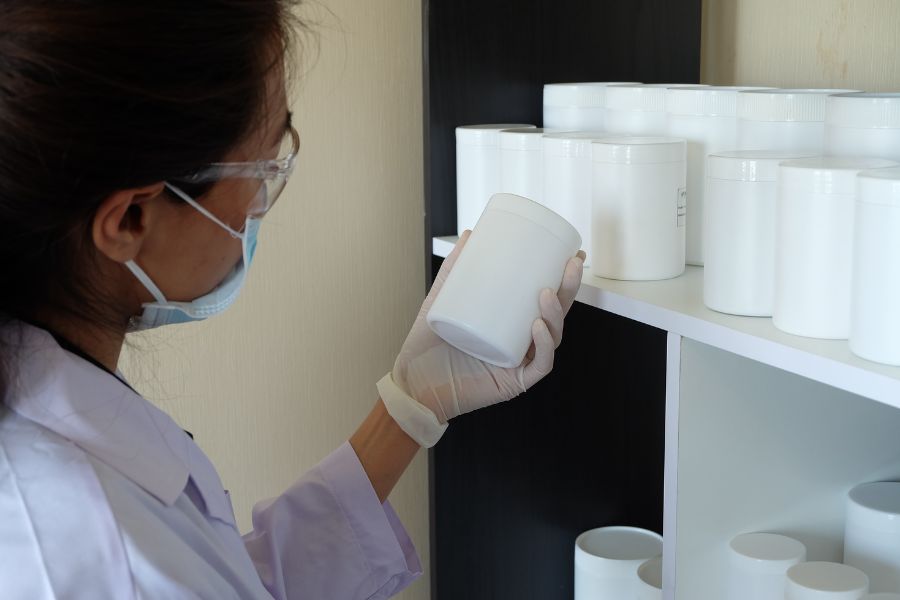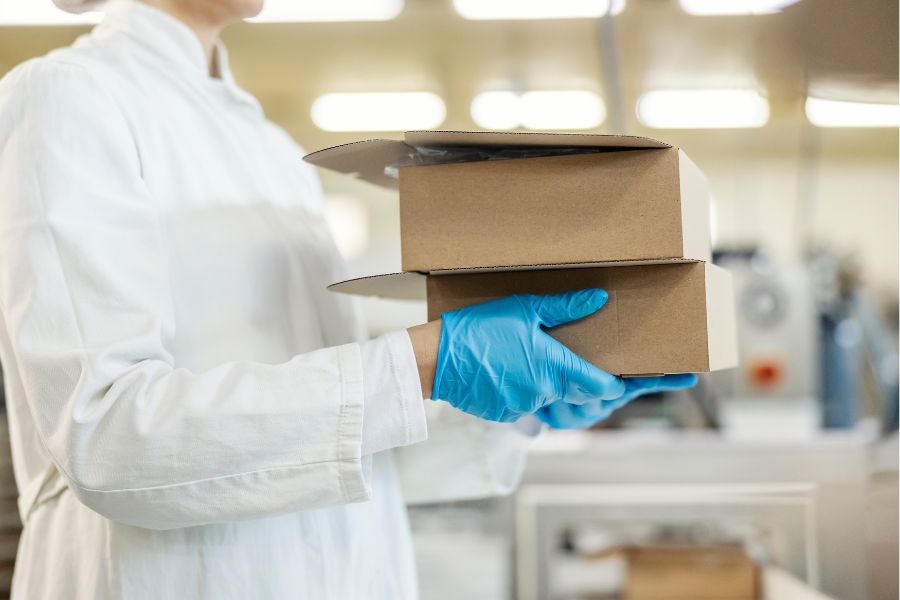Importance of Regular Packaging Quality Inspections
When creating products or manufacturing goods, quality control is essential. You don’t want to recall defective products or disappoint customers due to inadequate quality checks.
However, quality inspections extend beyond just the products themselves. It’s equally important to conduct quality inspections on your packaging to protect your items, enhance customer satisfaction, and prevent delays and costs. In this article, we’ll provide insights into what regular packaging inspections look like and why they matter.

What are Packaging Inspections?
A packaging inspection is a type of quality assurance that involves a thorough examination of your packaging products and raw materials to make sure they adhere to quality standards and quality control checks. These inspections test the quality of the materials and methods of packaging to make sure that all standards are met for integrity and safety.
In a packaging inspection, it’s important to do more than just glance over the packaging materials and components. You also need to dig a little deeper into your production process and go beyond the surface. A visual inspection will help you make sure that the packaging products aren’t damaged on the surface, as well as give you a chance to check for any design flaws, misprints, or tears in your vision systems.
You should also do a dimensional inspection to look at the different types of measurements of your packaging materials. Most of your packaging needs to snugly fit the products you are shipping. You want to have specific sizes of boxes or bottles for this purpose. If they are the wrong size, dimension, or shape, it can throw your entire packaging system off and disrupt your production line.
Another type of packaging inspection you’ll want to include is a material testing inspection. As with the dimensions of your packaging, the type of material used in each product’s packaging also plays a key role in your delivery and shipping processes. For example, if you usually ship a product in plastic but convert it to glass packaging instead, material testing is vital for switching to a more fragile solution. Negligence can cause safety issues to end users and the environment during transportation, affecting your shipping methods and leading to issues down the line.

Why Are Regular Packaging Inspections Important?
While packaging mistakes might initially seem like no big deal, they can have far-reaching consequences. Overlooking minor deviations, such as carton size or material strength, might seem like a convenient way to expedite product delivery. However, such errors can lead to major complications down the line and reflect poorly on your business. These include product damages, costly recalls, refund requests, customer service complaints, and shipping delays.
Setting up a regular packaging inspection procedure can help businesses catch defects and deviations in product quality. Conducting frequent product inspections not only helps ensure that companies are staying on top of the quality control and safety standards before their products reach consumers but also provides the following benefits:
Ensured Product Protection
Primarily, packaging serves the essential purpose of protecting your products and ensuring they reach customers in optimal condition. Compromised packaging quality or damage that could have been spotted with a thorough inspection can put your products at risk. This is particularly crucial for industries like food manufacturing, pharmaceuticals, and chemicals, where products and packaging need to be held to a very high standard. For instance, a bottle made from the wrong material or a damaged lid could contaminate products and potentially the environment around it. Such incidents can lead to significant customer issues or heavy fines and hurt your business’s reputation.
Maintaining Brand Image
High-quality packaging materials and thoughtful branding play a key role in your brand identity. Packaging is an extension of branding and marketing, providing a medium to share messages, promote related products, and increase brand recognition through logos, colors, and designs.
Damaged, misprinted, or poor-quality packaging materials can undermine brand image and hinder growth. Once manufacturers can get their products onto store shelves, it’s imperative that your product packaging and branding are ready for consumers.
Regulatory Compliance
Many industries have strict compliance regulations that must be followed for the products to be sold. Packaging is also subject to compliance regulations. Adhering to these regulations is crucial to avoid legal issues and maintain compliance. For instance, in the food and beverage industry, ensuring food safety is of utmost importance.
Regular quality assurance inspections help maintain the necessary standards within your industry. They offer an opportunity to verify regulatory compliance before shipping products from your warehouse or fulfillment center. Neglecting regular packaging inspections could put your business at major risk of lawsuits, fines, and reputational damage.
Cost Savings
The importance of quality inspections becomes clear when considering the packaging cost savings they provide. Poor-quality packaging can result in expensive product recalls, replacements, and damage to customer relationships. These issues can also burden customer service teams, lead to costly PR efforts, and result in fines or penalties for non-compliance with industry standards.
Although quality assurance inspections may seem unnecessary at first, they can save companies thousands of dollars over time. By investing in a consistent inspection process, businesses can avoid shipping delays, recalls, and additional costs. A commitment to quality may even qualify companies for discounts or other incentives on future packaging orders.
What to Look for During a Packaging Inspection
When conducting a packaging inspection, there are several key areas to focus on. These areas are the most susceptible to errors that could compromise the quality of your packaging. These are also crucial factors in determining the overall quality of your material components, making it essential to scrutinize these areas during your inspection process to ensure the integrity of your packaging.
Material Quality
When selecting packaging materials, it’s essential to consider the material’s quality. The type of packaging material used can significantly impact the quality of the product inside. Durability, performance, and regulatory compliance can all be affected if the packaging material is not suitable. Testing the materials before use can help ensure a higher quality packaging solution to protect your product.
Construction and Seals
It’s also important to look at the construction of the packaging materials, especially if you require multiple components to package products. Test the seals and lids of your bottles or containers to make sure they hold up. Do multiple test runs to make sure that the product is consistently secured through various conditions.
Labeling
Another common area where mistakes are made in packaging is on the labeling. As previously mentioned, your packaging serves as an extension of your marketing and branding efforts. If the label contains misprints or lacks essential elements of your creative design, it can undermine the professionalism of your product and fail to fully communicate important information or brand elements. To avoid such issues, carefully read and examine the labels in your packaging materials to ensure accuracy and consistency with your overall brand identity. Custom packaging labels are another way to stand out in the market and ensure your labels contain all of your required information.
Printing Quality
When ordering packaging materials in bulk, pay close attention to the printing quality. Occasionally, the machine used for printing may not be functioning correctly, resulting in blurry images, smeared words, or other mishaps. Similar to labeling errors, these printing issues can negatively impact your company and brand image. To ensure high-quality printing, make sure the images have a high resolution, as this plays a crucial role in an effective package inspection. In case of print quality issues, a thorough inspection of the finished product can catch these errors before it is too late.

How Often Should Packaging Inspections Be Conducted?
To ensure the integrity and quality of your packaging, regular thorough inspections are recommended a few times a year. These inspections should encompass testing of the packaging materials, individual components, and various performance categories. For industries with stringent regulations, such as the pharmaceutical industry, it is advisable to engage a third-party inspector. Additionally, inspections should be conducted whenever there is a change in packaging materials, the introduction of a new product with unique packaging requirements, or a change in packaging suppliers or vendors.
It’s also a good idea to always do a visual inspection on packaging materials when you get a new shipment. By quickly scanning the label, examining the printing, and assessing the overall size of the packaging products, potential issues can be identified early on, saving time and resources in the long run.
Create a Packaging Quality Control Checklist
If you are unsure of where to begin with packaging quality control, then a simple checklist can be a good starting point. A packaging quality control checklist gives your floor operators a direct reference for what to look for and how to conduct their inspection in the factory during the packaging process.
Ensure that your packaging checklist is standardized and clearly explained to inspectors on the manufacturing floor. Document and record all information gathered during inspections for future reference. Establish a clear, repeatable process for testing packaging materials, eliminating subjective interpretations. Incorporate specific industry technologies or testing equipment into your inspection systems when necessary.
It’s crucial to have a plan in place for addressing issues identified during quality inspections. When packaging material is damaged, have a strategy ready to address the problem immediately to avoid shipping delays or backlogs. Follow up to ensure that corrective action steps are taken to meet required standards.
Hayley is a marketing professional and copywriter with a background in crafting content for a diverse range of industries. She has been writing about packaging and supply chain logistics for Paramount Global since 2022. She specializes in explaining complex topics in a clear and engaging way and is an advocate for sustainability in packaging and supply chain management.
Read More
For over forty years, Paramount has been delivering perfectly integrated packaging and supply chain solutions.
